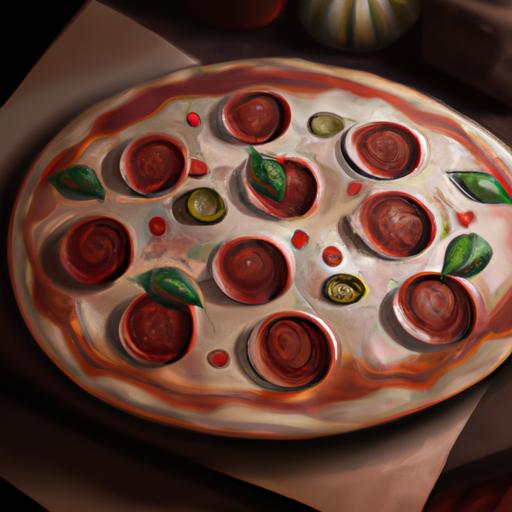Do you love pizza but suffer from diverticulitis? You may have been told to avoid pizza, but the answer may surprise you! In this article, youll discover the facts about eating pizza with diverticulitis, the benefits, how to choose the right pizza and toppings, and tips for eating pizza that wont aggravate your condition.
Youll also find out how to make sure youre getting the nutrition you need while enjoying your favorite pizza.
So, read on to find out if you can enjoy pizza while managing your diverticulitis.
Table of Contents
Short Answer
It is generally recommended that people with diverticulitis follow a low-fiber diet to reduce symptoms.
This means that people with diverticulitis should avoid eating foods that are high in fiber, such as pizza crusts and toppings made with whole grains.
However, if the pizza has a thin crust and is topped with vegetables that are low in fiber, it may be possible to eat pizza with diverticulitis.
It is best to speak to your doctor to determine which foods are safe to eat with diverticulitis.
What is Diverticulitis?
Diverticulitis is a condition that affects the large intestine, or colon.
It occurs when small, bulging pouches called diverticula become inflamed and infected.
Diverticulitis can cause abdominal pain, cramping, and nausea, and can lead to serious complications if left untreated.
It is important to pay attention to the symptoms and to seek medical attention if the condition worsens.
Diet is an important factor in managing diverticulitis, and certain foods can cause flare-ups or irritation.
When it comes to eating pizza with diverticulitis, it is important to take certain precautions.
Eating a pizza with a thin crust and low-fat toppings may be beneficial, as the crust will be easier to digest and the toppings will be less likely to cause irritation.
Additionally, avoiding acidic toppings such as tomatoes and olives, as well as spicy toppings, can help reduce the risk of flare-ups.
Eating small portions of pizza and avoiding overeating may also be beneficial.
Overall, it is possible to enjoy pizza with diverticulitis if certain precautions are taken.
However, it is important to remember that diet is only one aspect of managing the condition.
Eating a healthy, balanced diet, as well as getting regular exercise and managing stress, can help reduce the risk of flare-ups and keep the condition under control.
Can You Eat Pizza with Diverticulitis?

For those who suffer from diverticulitis, the thought of eating pizza may seem like an impossible dream.
Unfortunately, the high-fat content and acidic ingredients of pizza can cause flare-ups or worsen the condition.
However, with a few simple precautions, you can enjoy a slice or two of pizza without worrying about a flare-up.
The first step is to look for a pizza with a thin crust and low-fat toppings.
This will help to reduce the amount of fat and calories that you are consuming.
It is also important to avoid acidic toppings such as tomatoes and olives, as well as spicy toppings.
These can be especially irritating to the condition and may cause a flare-up.
Eating pizza in small portions is another way to reduce the risk of flare-ups.
Eating too much pizza can be hard on your digestive system, so it is important to keep your portions small.
Additionally, it is important to avoid overeating in general.
Eating a healthy, balanced diet is the best way to manage diverticulitis.
With these precautions in mind, it is possible to enjoy the occasional slice of pizza with diverticulitis.
However, it is important to remember that the condition can be unpredictable, so it is always best to consult with your physician before making any changes to your diet.
Benefits of Eating Pizza with Diverticulitis
Eating pizza with diverticulitis doesnt have to be a challenge.
In fact, it can even be beneficial if done in moderation and with the right ingredients.
Eating pizza with diverticulitis can provide several benefits, including a boost in nutrition and some much-needed comfort food.
For starters, pizza can be a great source of nutrition.
It can provide important vitamins, minerals, and proteins that you may be lacking in your diet.
Cheese, a common topping, is a great source of calcium, which is important for bone health.
Depending on your toppings, pizza can also provide dietary fiber, iron, and other important nutrients.
Pizza can also provide comfort.
For some, eating pizza can bring back fond memories of childhood or family gatherings.
Eating pizza can be a way to treat yourself and enjoy a delicious meal.
Plus, pizza is an easy-to-eat food that can be shared with friends and family.
Finally, pizza can be a great way to get creative with your diverticulitis diet.
You can find recipes that use a thin crust and low-fat toppings, such as mushrooms, onions, spinach, and peppers.
Or, you can make your own pizza with your favorite ingredients and create a unique flavor combination.
Overall, eating pizza with diverticulitis can be a great way to get the nutrition your body needs and enjoy a comforting meal.
Just make sure to look for a thin crust and low-fat toppings, avoid acidic and spicy toppings, and watch your portion size.
By doing so, you can enjoy a delicious pizza while helping to manage your diverticulitis.
Tips for Eating Pizza with Diverticulitis

Eating pizza with diverticulitis can be a challenge, but it doesnt have to be.
By following a few simple tips, you can still enjoy a slice of pizza without risking an uncomfortable and painful flare-up.
The first step to eating pizza with diverticulitis is to look for a pizza with a thin crust.
A thin crust will be easier to digest and less likely to cause a flare-up.
Additionally, look for a pizza with low-fat toppings such as grilled veggies, lean meats, and low-fat cheeses.
You should also avoid acidic toppings such as tomatoes and olives, as well as spicy toppings.
These ingredients are acidic and can irritate your diverticulitis.
Instead, opt for milder toppings such as mushrooms, peppers, and onions.
When it comes to pizza, its important to practice portion control.
Eating small portions of pizza and avoiding overeating can help reduce flare-ups.
Additionally, eating a healthy, balanced diet is the best way to manage diverticulitis.
By following these simple tips, you can still enjoy pizza while living with diverticulitis. With a little bit of planning and a few adjustments to your diet, you can still enjoy the occasional slice of pizza without risking a flare-up. So, the answer to the question Can you eat pizza with diverticulitis? may surprise you: yes, you can!
Choosing the Right Pizza
For those with diverticulitis, choosing the right pizza can be a challenge.
While some people may want to indulge in their favorite pizzas with thick crusts and cheesy toppings, these types of pizzas can cause flare-ups or aggravate the condition.
Instead, it is best to look for a pizza with a thin crust and low-fat toppings.
Additionally, acidic toppings such as tomatoes and olives, as well as spicy toppings, should be avoided.
When it comes to finding the right pizza, it is important to read the ingredient list carefully.
This will help to ensure that you are selecting a pizza that is low in fat and free of any ingredients that may be irritating to your diverticulitis.
Additionally, selecting a pizza made with whole grain crust can provide additional health benefits.
It is also important to pay attention to portion sizes.
Eating a large slice of pizza may cause flare-ups, so it is best to limit your consumption to a small slice.
Additionally, it is important to avoid overeating in general, as this can aggravate the condition.
Overall, it is possible to enjoy pizza with diverticulitis, but it is important to take certain precautions.
By looking for a pizza with a thin crust and low-fat toppings, avoiding acidic and spicy toppings, and limiting portion sizes, you can enjoy pizza without aggravating your diverticulitis.
However, it is important to remember that eating a healthy, balanced diet is the best way to manage your condition.
Avoiding Certain Toppings

When it comes to eating pizza with diverticulitis, it is important to be mindful of the toppings that you choose.
Certain toppings can cause flare-ups or irritate the condition, so it is best to avoid them.
For instance, acidic toppings such as tomatoes and olives may cause problems, as they can increase intestinal irritation.
Additionally, spicy toppings can be problematic, as they can aggravate the inflammation associated with diverticulitis.
To be on the safe side, it is best to stick with low-fat toppings such as mushrooms, peppers, and onions.
Another way to reduce the risk of flare-ups is to limit the portion size of the pizza that you eat.
Eating too much pizza in one sitting can cause a flare-up, so it is best to stick to small portions.
Additionally, it is important to remember that pizza should not be a major part of your diet if you have diverticulitis.
Eating a healthy, balanced diet is the best way to manage the condition, so make sure to include plenty of fiber-rich vegetables, lean proteins, and whole grains in your meals.
Eating Healthy with Diverticulitis
When it comes to managing diverticulitis, the best way to go is to eat a healthy and balanced diet.
This means eating plenty of fiber-rich foods such as fruits, vegetables, and whole grains while limiting intake of processed and fatty foods.
Foods that are high in fiber can help to reduce flare-ups and provide the necessary nutrients needed to keep the digestive system functioning properly.
Additionally, it is important to stay hydrated and drink plenty of water throughout the day.
When it comes to eating pizza with diverticulitis, it is important to take certain precautions.
While it may be tempting to indulge in a delicious deep-dish pizza with all of your favorite toppings, it is important to consider what goes into the pizza and how it may affect the condition.
A thin crust pizza with low-fat toppings is usually the best option, as they are less likely to cause flare-ups or irritation.
Additionally, acidic toppings such as tomatoes and olives, as well as spicy toppings, should be avoided.
Eating small portions of pizza and avoiding overeating is also important, as this can help to reduce the chances of a flare-up.
Overall, it is possible to eat pizza with diverticulitis, but it is important to take certain precautions and be mindful of what goes into the pizza.
Eating a healthy, balanced diet is the best way to manage the condition, and pizza should be enjoyed in moderation.
Final Thoughts
It is possible to enjoy pizza with diverticulitis, but it is important to take certain precautions.
Look for a pizza with a thin crust and low-fat toppings, and avoid acidic and spicy toppings.
Eating small portions of pizza and avoiding overeating may also help reduce flare-ups.
Ultimately, eating a healthy, balanced diet is the best way to manage diverticulitis.
So, if you have diverticulitis, don’t be afraid to enjoy a slice of pizza – just remember to take the right precautions and practice moderation.

